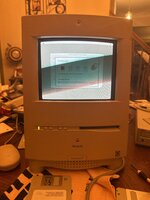Hi,
I recently picked up a Color Classic II with a dead hard drive and tried to boot from a BlueSCSI v2 DB25 from the external SCSI port. The BlueSCSI was purchased form Joe's Computer Museum preassembled. All I kept getting is the floppy icon with flashing question mark. I've followed the instructions from the BlueSCSI website to the letter and tried a couple different SD cards but kept getting the same error.
Here's what I did:
Here is the content from log.txt in the SD card after trying to boot:
[12ms] Platform: BlueSCSI Pico
[12ms] FW Version: 2023.07.08-dev Aug 10 2023 15:51:08
Flash chip size: 2048 kB
=== SD Card Info ===
SD card detected, exFAT volume size: 29813 MB
SD Name: SPCC , MID: 0x9F, OID: 0x54 0x49
=== Global Config ===
Config file bluescsi.ini not found, using defaults
Active configuration:
=== Finding images in / ===
== Opening /CD3 Legacy Recovery.iso for ID: 3 LUN: 0
---- Configuring as CD-ROM drive based on image name
---- Image ready
== Opening /HD60_512 MacHD.hda for ID: 6 LUN: 0
---- Image ready
== Opening /HD20_512 Backup.hda for ID: 2 LUN: 0
---- Image ready
=== ROM Drive ===
Platform supports ROM drive up to 1692 kB
---- ROM drive image not detected
=== Configured SCSI Devices ===
* ID: 2, BlockSize: 512, Type: Fixed, Quirks: Apple, Size: 2097152kB
* ID: 3, BlockSize: 2048, Type: Optical, Quirks: Apple, Size: 663482kB
* ID: 6, BlockSize: 512, Type: Fixed, Quirks: Apple, Size: 2097152kB
Initialization complete!
Termination was set to ON and I also tried with and without USB power. The power light (white LED) would stay on and the blue LED would flash once briefly on boot but that's it. I also tried Mac Plus and MegaSTE hacks from ini.bluescsi.com and those did not work either. I also tried different images from SavageTaylor.com with various versions of Mac OS preinstalled (with proper naming) and none of them worked. At this point I'm wondering if the BlueSCSI is DOA or if there are other configs I need to add in the BlueSCSI.ini to get it to work.
Btw, the computer is able to boot from the original installation floppy disk that came with it. However, since it is in Japanese, I am not able to read it. Any help at this point is greatly appreciated. Thank you.
I recently picked up a Color Classic II with a dead hard drive and tried to boot from a BlueSCSI v2 DB25 from the external SCSI port. The BlueSCSI was purchased form Joe's Computer Museum preassembled. All I kept getting is the floppy icon with flashing question mark. I've followed the instructions from the BlueSCSI website to the letter and tried a couple different SD cards but kept getting the same error.
Here's what I did:
- Formatted SD Card (a 16GB and a 32GB) as ExFAT.
- Installed System 7.5.3 then upgraded to 7.5.5 in BasiliskII to a 2GB HDD image.
- Name the image HD60_512 MacHD.hda.
- Copy the image to the SD card.
- Plug the SD card into BlueSCSI v2 DB25.
- Plug BlueSCSI v2 DB25 into the external SCSI port.
- Turn on the computer.
[12ms] Platform: BlueSCSI Pico
[12ms] FW Version: 2023.07.08-dev Aug 10 2023 15:51:08
Flash chip size: 2048 kB
=== SD Card Info ===
SD card detected, exFAT volume size: 29813 MB
SD Name: SPCC , MID: 0x9F, OID: 0x54 0x49
=== Global Config ===
Config file bluescsi.ini not found, using defaults
Active configuration:
=== Finding images in / ===
== Opening /CD3 Legacy Recovery.iso for ID: 3 LUN: 0
---- Configuring as CD-ROM drive based on image name
---- Image ready
== Opening /HD60_512 MacHD.hda for ID: 6 LUN: 0
---- Image ready
== Opening /HD20_512 Backup.hda for ID: 2 LUN: 0
---- Image ready
=== ROM Drive ===
Platform supports ROM drive up to 1692 kB
---- ROM drive image not detected
=== Configured SCSI Devices ===
* ID: 2, BlockSize: 512, Type: Fixed, Quirks: Apple, Size: 2097152kB
* ID: 3, BlockSize: 2048, Type: Optical, Quirks: Apple, Size: 663482kB
* ID: 6, BlockSize: 512, Type: Fixed, Quirks: Apple, Size: 2097152kB
Initialization complete!
Termination was set to ON and I also tried with and without USB power. The power light (white LED) would stay on and the blue LED would flash once briefly on boot but that's it. I also tried Mac Plus and MegaSTE hacks from ini.bluescsi.com and those did not work either. I also tried different images from SavageTaylor.com with various versions of Mac OS preinstalled (with proper naming) and none of them worked. At this point I'm wondering if the BlueSCSI is DOA or if there are other configs I need to add in the BlueSCSI.ini to get it to work.
Btw, the computer is able to boot from the original installation floppy disk that came with it. However, since it is in Japanese, I am not able to read it. Any help at this point is greatly appreciated. Thank you.

